
pears, as well as two kinds of apples, Cox’s Orange and Cox’s Pomona. In 1
Gothland is also cultivated the Stenkyrke apple, in Halland and in south Kalmar I
liin, Gravenstein. In the second zone are produced, op the whole, the finest apples I
particularly Gravenstein, the Akero apple, and Yellow Richard. In the third I
zone the Akero, Savstaholm, and the Oranie apples predominate. In both the 1
second and the third zone are also cultivated with success certain finer kinds I
of pears, such as the Fondante d’automne, Yat Yutte, and Moltke pears; in I
the second zone also Louise Bonne of Jersey, and William. These three are the I
fruitgrowing zones: in the fourth and fifth fruit-growing is of minor importance. I
P h o to . E . SlDENBLADH J :it.
Scene in Norsborg Park, Sodermanland.
Within the three first zones a number of Fruit-growers’ Associations strive to
promote the cultivation of fruit. Eaeh of thèse associations keep a pftradr
skôtare”, that is, a man whose business it is to do skilled gardening work in
the orchards of the members; for this work he is paid according to a fixed
rate. In certain Ians, such as for instance in Sodermanland, there are over 60
of these associations. In that lan these associations are in turn amalgamated
into one big Union, embracing the whole of the lan; it has instituted several
“fruit depots”, that is, magazines to which the fruit-growers can send their fruit.
The fruit is then sorted and packed, and sold through the agency of the
superintendent of the depot. The Union also undertakes the purchase of materials
required for the orchards.
In recent years fruit-drying establishments of the same kind as those in the
United States have been-erected in several places, and it is now only a question
of time when Sweden will produce enough dried fruit to supply home needs.
Cherries and plums are cultivated to a considerable extent, particularly h1
| the first three zones. Gooseberries, currants, raspberries, and strawberries are
: grown almost all over Sweden. During the, last few years, however an
epidemic fungus disease “the American gooseberry-mildew” has greatly hindered
the cultivation of the chief kinds of berries. Peaches, apricots, walnuts and
mulberries can be successfully cultivated in the open only in certain parts of
the first zone. Grapes and peaches, on the other hand, are pretty generally
cultivated under glass.
Large orchards are pretty common. The largest are at Helmershus, Halsing-
borg and Bastad in Skane, Adelsnas and Norrviken in Ostergotland and at
Gripsholm in Sodermanland. The number of fruit-trees in each of these plantations
varies between 8 000 and 6 000.
Groups o f Cactuses in Humlegarden Park, Stockholm.
L c f “garden“ " H | of f t ke® M e re s t taken in fruit-growing
' years KotwHL + nef. > n cam ed up to a high standard during recent
T T S e r i f 8 H i b e e n l a i d 0 U t a n d t h e o l d ° » e s [so that import h i h y gl Products is at present rather scanty,
roses. 6C0me n6Cessary’ especially of certain articles, such as
th e^ con lf I P be®n „grea1Jy developed, as is attested by the fact
[during the last tw e ptl011 of lowers has been increased many times over
able to cope ^ th + h f / eaV A a Afloriculturalists as a whole are now
are imported 1 1 1 7 At preSent bardly any other flowers
[February. The v a h m S llf iP t T ^ months from December to
more than 111 616 kronor6 lmport of flowera did not amount in 1913 to